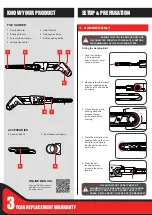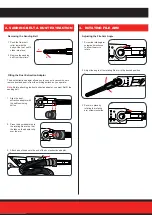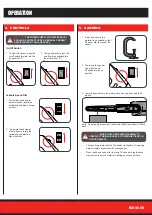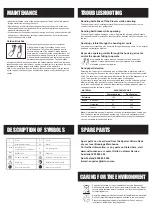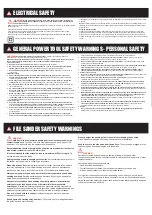
Power tools that are no longer usable should not be disposed of
with household waste but in an environmentally friendly way. Please
recycle where facilities exist. Check with your local council authority
for recycling advice.
Recycling packaging reduces the need for landfill and raw materials.
Reuse of recycled material decreases pollution in the environment.
Please recycle packaging where facilities exist. Check with your
local council authority for recycling advice.
SPARE PARTS
Spare parts can be ordered from the Special Orders Desk
at your local Bunnings Warehouse.
For further information, or any parts not listed here, visit
www.ozito.com.au or contact Ozito Customer Service:
Australia 1800 069 486
New Zealand 0508 069 486
E-mail: [email protected]
DESCRIPTION OF SYMBOLS
CARING FOR THE ENVIRONMENT
MAINTENANCE
• Keep the ventilation vents of the sander clean at all times, if possible, prevent
foreign matter from entering the vents.
• After each use, blow air through the sander housing to ensure it is free from
all dust particles which may build up. Build up of dust particles may cause the
sander to overheat and fail.
• If the enclosure of the sander requires cleaning, do not use solvents but a moist
soft cloth only. Never let any liquid get inside the sander; never immerse any
part of the sander into a liquid.
Carbon Brushes
When the carbon brushes wear out, the sander
will spark and/or stop. Discontinue use as soon
as this happens. They should be replaced prior to
recommencing use of the sander. Carbon brushes
are a wearing component of the sander therefore not
covered under warranty. Continuing to use the sander
when carbon brushes need to be replaced may cause
permanent damage to the sander. Carbon brushes
will wear out after many uses but when the carbon brushes need to be replaced,
take the sander to an electrician or a power tool repairer for a quick and low cost
replacement. Always replace both carbon brushes at the same time.
Note: Ozito Industries will not be responsible for any damage or injuries caused
by the repair of the sander by an unauthorised person or by mishandling of the
sander.
TROUBLESHOOTING
Sanding belt slides off the file arm while operating
The sanding belt is not installed correctly. Ensure that you align the belt on the
centre of the front and rear guide rollers.
Sanding belt breaks while operating
The sanding belt may be damaged or worn. Replace the sanding belt and ensure
that the sanding belt is installed so that the rotation direction matches the arrows on
the tool.
Sparking visible through the housing air vents
A small amount of sparking may be visible through the housing vents. This is normal
and does not indicate a problem.
Excessive sparking visible through the housing air vents
and/or the sander failing to operate
May indicate the carbon brushes have worn out and need to be
replaced. Carbon brushes should only be replaced by a qualified
electrician or power tool repairer.
Sandpaper Selection
Selecting the correct grit of sandpaper is an important step in achieving optimum
results. Coarse grit will remove the most material. Finer grit will produce a smoother
finish. The condition of the work piece will determine the grit of the sandpaper to be
used. The higher the grit number, the finer the grade of sandpaper.
If the surface is rough, start with a coarse grit and sand until the surface is uniform.
Medium grit may then be used to remove scratches left by the coarser grit. Finer
grit is then used to finish the surface. Always continue sanding with each grade of
sandpaper until the surface is uniform.
MATERIAL
APPROPRIATE GRIT
Coarse Sanding
Fine Sanding
Paintwork
180
400
Wood
: Softwood
60
240
Hardwood
60
180
Veneer
240
320
Note
: If intermediate sanding is required, choose a grit rating between coarse and
fine. The above table is intended as a guide only. To ensure a satisfactory result,
a small, inconspicuous area should first be tested to ensure the grit of sandpaper
chosen is suitable for the desired finish.
Warning
Read instruction manual
Wear eye protection
Double insulated
/min
Revolutions or
reciprocation per minute
n
0
No load speed
V
Volts
Hz
Hertz
~
Alternating current
W
Watts
Diameter
Regulator compliance mark
Wear ear protection
mm
Millimetres


